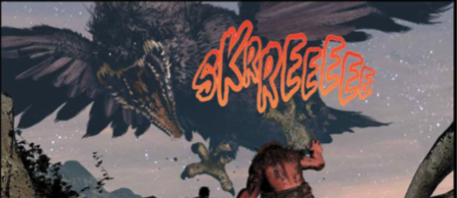Sonata #2 // Review
An ever-curious adventurer finds herself in an ancient hidden temple of some sort. One would think that she might be cautious about touching anything in the ancient ruins. One might not, for instance, expect her to suddenly activate some ancient technology that would catapult her, her friend and a stranger to the other side of the planet. This is, of course, exactly what happens in the second issue of Sonata. Writer David Hine and artist Brian Haberlin intensify the adventure in an issue that is swimming with mystery. Color comes to the issue courtesy of Geirrod Van Dyke. The dialogue might feel a bit clunky, but the visuals of the steampunk fantasy world make this a very satisfying second issue.
Sonata and her large gentle, ogre-like Lumani friend are exploring the ancient ruins of some underground temple-like structure. Sonata’s curiosity leads her to identify some sort of script that’s been carved into the walls. It appears to be Lumani...but her friend seems dismissive, saying the Lumani have no written language. The mystery of the ancient underground structure is shelved when Sonata notices an ornate, casually-placed bracelet with a huge gem on it that opens a portal to the other side of the planet. If they’re going to be able to make it back home, they’re going to have to survive the massive local wildlife on the south side of the planet.
Hine’s overall plotting makes for a fun adventure story. The pacing works well as Sonata and company move from location to location on a tremendous, sweeping adventure. The big flaw in Hine’s writing is dialogue. A fantasy world that isn’t based on anyone specific point in history leaves way too much room for interpretation of fantasy dialects. Characters in Sonata’s world speak with awkward angles. When it is revealed to Sonata’s father that she’s on the south side of the planet “Two thousand Kubits south of here,” his response is: “That would take a dozen rotation of travel.” Okay...it’s clear that he’s talking about 12 days, but it the formality of his speech feels stiff and awkward without adding anything to the atmosphere of the world. The issue opens on a similarly awkward narration regarding an old aphorism featuring “Laska fruit” and “Mushida berries.” It’s an attempt to render some feeling of fantasy about the world, but it just feels stiff.
The art, on the other hand, is far from stiff. Haberlin’s rendering of the world is deeply atmospheric. The graininess of the Sonata’s planet creates a beautiful, otherworldly feel about the title. Haberln’s process gives a profound sense of depth to the page. Van Dyke’s colors amplify this for a breathtaking sense of perspective. Giant monsters in Sonata’s world feel truly massive contrasted against main characters in the foreground in a delicate interplay of ink and color.
It’s not terribly original, but Hine and Haberlin delicately place a traditional pulp fantasy story in a breathtakingly unique world that’s loving rendered in great detail. The fantastic nature of the world might be amplified with a bit more of a sense of mystery. The dialogue is definitely weighing down that mystery, but it’s still a solidly fun fantasy.










